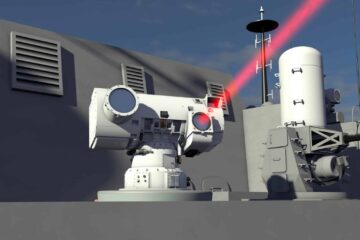Royal Navy press release
On a landmark seven-month mission – the most significant peacetime deployment by the Royal Navy in a generation – the aircraft carrier and her task group of eight supporting ships, a submarine, five air squadrons and more than 3,700 personnel visited more than 40 countries.
Her F-35B stealth jets flew more than 4,000 hours – more than 23 weeks in the skies, including combat sorties bombing remaining elements of Daesh – while the ship worked with allied and partner nations forging new ties, renewing old friendships and flying the flag for Britain.
Sailors from the carrier will now be reunited with their families for Christmas after the mission that took the UK Carrier Strike Group 49,000 nautical miles as far east as Japan and Guam and back through the Atlantic, Mediterranean, Suez Canal, the Indian Ocean and to the Pacific.
Queen Elizabeth returned after some of her escort warships, which formed a protective ring around the aircraft carrier during her operations.
Type 45 destroyers HMS Defender and HMS Diamond sailed into Portsmouth this morning while HMS Richmond sailed back to Devonport earlier today.
Families gathered in Portsmouth to greet their loved ones – some of whom return from their first deployment and others who are putting the seal on the latest milestones in their naval careers.
Able Seaman Thomas Corby, who completes his first ever deployment, said: “The thing that I am most looking forward to when I get home is being able to hug my grandparents again for the first time in nearly two years owing to Covid and the deployment.”
For Flight Deck Officer Lieutenant Commander Richard Turrell, the return marks the end of his last deployment at sea.
“I look back on over ten years spent at sea operating carrier flight decks all over the world,” he said.
“This is my final deployment at sea and I have completed my career on board the UK’s flagship carrier as the Flight Deck Officer, responsible for four acres of sovereign territory and an air wing of 28 aircraft.
“This has been personally and professionally rewarding and I will look back over the past two and a half years with immense pride at what the flight deck party have achieved, taking a ship from first of class flying trials, through Operational Sea Training to a deployment across the globe on Operation Fortis.”

The aircraft carrier and her strike group sailed a combined 500,000 nautical miles and strengthened bonds with allies, including Australia, Canada, New Zealand, France, Greece, Israel, India, Italy, Japan, Oman and the Republic of Korea.
The task group was also a notable international effort, with Dutch frigate Evertsen and US Navy destroyer USS The Sullivans sailing side by side with seven British ships on the deployment.
US Marine Corps jets were also deployed alongside the RAF’s 617 Squadron on board HMS Queen Elizabeth, assembling the largest contingent of fifth-generation stealth jets ever seen at sea.
HMS Queen Elizabeth’s Commanding Officer Captain Ian Feasey said: “This seven-month deployment has proven a resurgent Carrier Strike capability for UK Defence.
“It would not have been possible without the professionalism, determination and self-sacrifice of the 1500 sailors, airmen and marines who have worked tirelessly to deliver all that was asked of them.
“The safe return and operational successes of HMS Queen Elizabeth are testament to their commitment and energy. They have turned a Royal Navy aircraft carrier into a national flagship, and it has been a privilege to be their Commanding Officer.”
During more than seven months away, sailors consumed an impressive 25.5 tonnes of sausages, 2.1 million eggs, 190,000 potatoes (equivalent weight of 15 London buses), 22,700kg of Angel Delight, 1.2 million rashers of bacons and 355,200 pints of milk.
On top of that, 40 tonnes of mail was delivered to those on board.






